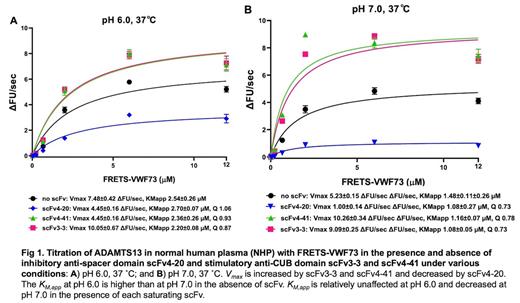Background and objective: Immune thrombotic thrombocytopenic purpura (iTTP) is an antibody-mediated life-threatening disease, caused by severe deficiency a plasma metalloprotease ADAMTS13 that impairs the cleavage of ultra-large von Willebrand factor (VWF). This leads to catastrophic microvascular thrombosis and angiopathic hemolysis. Exploring the mechanism of antibodies that inhibit ADAMTS13 under physiologic conditions and standard assay conditions for diagnosis of iTTP (pH 6.0) may help better understand the pathophysiology of iTTP. Our previous study suggests that an inhibitory anti-ADAMTS13 antibody may affect catalytic turnover of the enzyme more than its apparent substrate binding affinity. Here, we describe a rigorous method to quantitatively determine thermodynamic linkage between antibody binding and substrate binding affinity under various conditions. We used well-characterized single chain fragments of the variable loop (scFv's) identified from a phage display library derived from several iTTP patients, and compare the apparent Michaelis constant ( K M,app,) and the maximal enzyme velocity ( V max) of ADAMTS13-mediated VWF cleavage in conditions that more closely represent plasma and in standard conditions. We also describe the stimulatory effect of a newly characterized scFv that targets the C-terminus of ADAMTS13.
Methods: Single chain fragments of the variable region (scFv4-20, scFv3-3 and scFv4-41), isolated by phage display from a human anti-ADAMTS13 antibody library derived from iTTP patients, were expressed and purified. ADAMTS13 in normal human plasma was titrated with increasing concentrations of the fluorescently labeled surrogate substrate FRETS-VWF73 to derive V maxand K M,appin the standard assay conditions (pH 6.0) and the conditions closer to physiologic pH (pH 7.0). The same parameters were derived in the presence of saturating concentrations of scFv's. Reaction quotient (Q), which defines thermodynamic linkage between an allosteric effector and substrate, is derived from the ratio of K M,app when saturating scFv is present and K M,app without antibodies.
Results: The V max of VWF73 cleavage by ADAMTS13 was lower at pH 7.0 than at pH 6.0 (5.23 ± 0.15 ΔFU/sec vs 7.48 ± 0.42 ΔFU/sec, respectively), and K M,app at pH 6.0 (2.54 ± 0.26 µM) was higher than at pH 7.0 (1.48 ± 0.11 µM) in the absence of scFv. Saturating inhibitory scFv4-20 decreased V max at both pH 6.0 and pH 7.0 (4.45 ± 0.16 ΔFU/sec and 1.00 ± 0.14 ΔFU/sec, respectively); K M,app was relatively unaffected at pH 6.0 (2.70 ± 0.07 µM, Q 1.06) and decreased at pH 7.0 (1.08 ± 0.27 µM, Q 0.73). Saturating scFv3-3 and scFv4-41 increased V max at both pH 6.0 (9.86 ± 0.46 ΔFU/sec and 10.05 ± 0.67 ΔFU/sec, respectively) and 7.0 (9.09 ± 0.25 ΔFU/sec and 10.26 ± 0.34 ΔFU/sec, respectively); while in the presence of scFv3-3 and scFv4-41, K M,app decreased slightly at pH 6.0 (2.20 ± 0.08 µM, Q 0.87; and 2.36 ± 0.26 µM, Q 0.93, respectively) and more dramatically at pH 7.0 (1.08 ± 0.05 µM, Q 0.73; and 1.16 ± 0.07 µM, Q 0.78, respectively). (Figure 1).
Conclusions: These results indicate that anti-ADAMTS13 IgG-mediated effects on VWF cleavage may differ when comparing the standard and more physiologic pH conditions. At pH 7.0, both inhibitory and stimulatory scFvs exert a stronger effect on V max of VWF73 cleavage by ADAMTS13 than at pH 6.0. The scFv4-41, which was not previously characterized, had a stimulatory effect on ADAMTS13 very similar to the previously characterized scFv3-3. The K M,app decreases with the increasing of pH from 6.0 to 7.0, while the presence of saturated scFvs investigated in the study appears to increase apparent substrate binding affinity in conditions close to physiologic. The change of enzyme kinetics of VWF73 cleavage by ADAMTS13 in presence of saturated antibodies adds the understanding of iTTP pathophysiology and guide future investigative directions.
Key words: Immune thrombotic thrombocytopenic purpura; ADAMTS13, inhibitory and stimulatory antibody
Disclosures
Zheng:Sanofi: Consultancy, Honoraria; TAKEDA: Consultancy, Honoraria; GC Biopharma: Consultancy, Honoraria; Clotsolution: Other: Co-founder; Stago: Consultancy, Honoraria; Apollo: Consultancy, Honoraria.


This feature is available to Subscribers Only
Sign In or Create an Account Close Modal